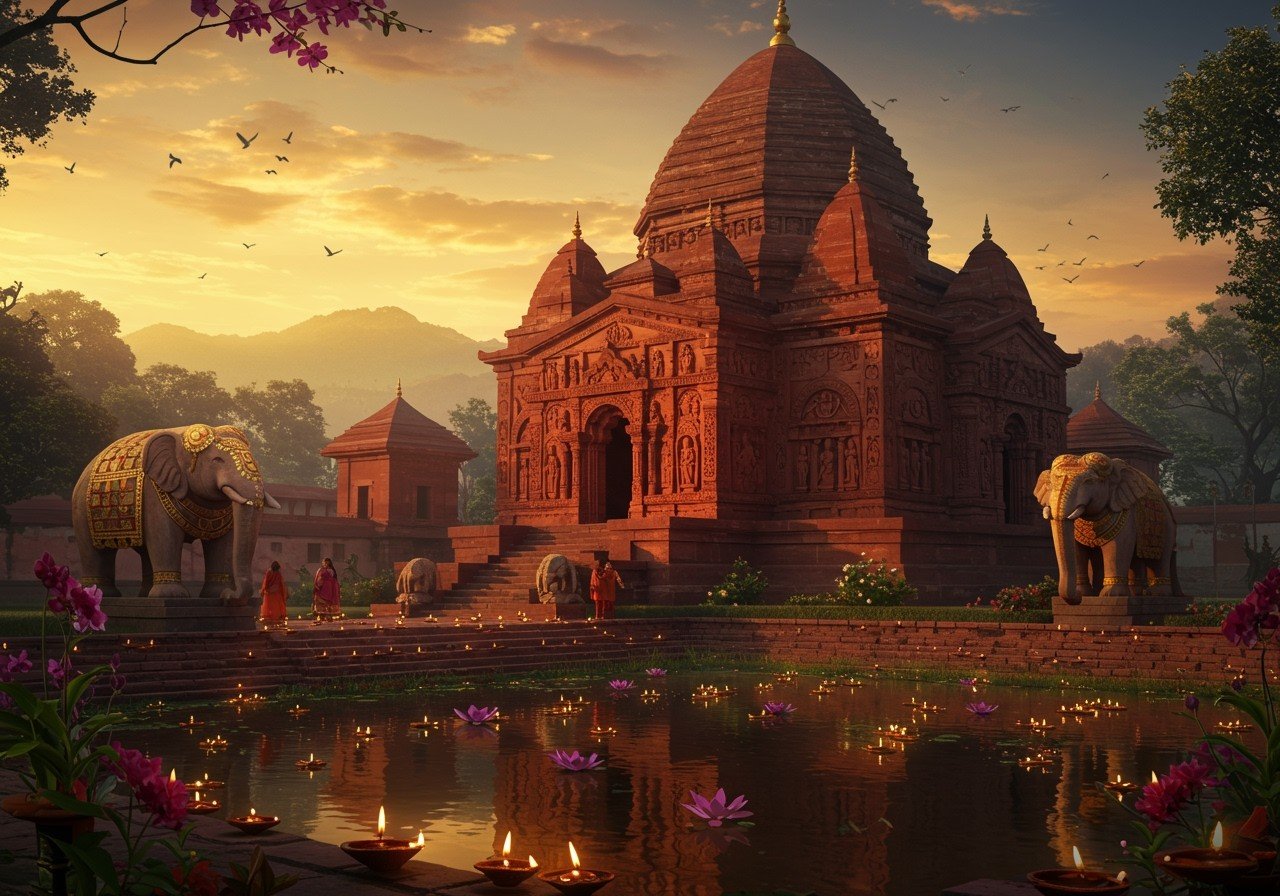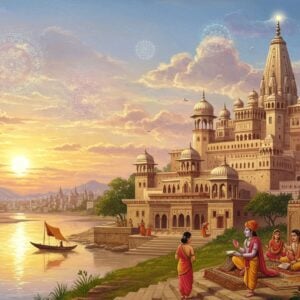
Assam, a land steeped in history and spirituality, is home to a treasure trove of ancient temples. These sacred spaces not only serve as places of worship but also stand as testaments to the region’s rich cultural heritage and architectural ingenuity. From the iconic Kamakhya Temple to the serene Umananda Temple, each shrine offers a unique glimpse into Assam’s vibrant past. Let’s embark on a journey to explore these architectural marvels and the spiritual essence they embody.
A Legacy in Stone: History of Assam’s Temples
The history of Assam’s temples is interwoven with the rise and fall of powerful dynasties, the ebb and flow of religious fervor, and the enduring spirit of the Assamese people. These temples are more than just structures; they are living narratives, whispering tales of devotion, artistry, and cultural exchange.
- These sacred sites are invaluable for understanding Assam’s history and culture, offering insights into the mysteries and evolution of Hinduism in the region.
- Guwahati, aptly named the “city of temples,” boasts a remarkable concentration of historically, architecturally, and spiritually significant temples. It’s a city where ancient traditions meet modern life, offering a unique spiritual experience.
- Many temples, particularly those showcasing intricate carvings and unique architectural styles, were constructed during the medieval period, a time of great artistic and spiritual flourishing. This period saw the development of distinct architectural styles like the Nilachal style, which became prominent under the Ahom kingdom. The Kamakhya temple is a prime example of this style, with its characteristic bulbous polygonal dome.
- The architectural heritage of Assam stretches back to the Gupta Period (5th-6th century) during the Varman dynasty’s rule in Kamarupa, marking the beginning of a rich architectural tradition in the region.
Sacred Shrines: Exploring Assam’s Notable Temples
Assam’s temples, each with its own unique story and significance, beckon devotees and history enthusiasts alike. Let’s delve into the stories behind some of Assam’s most revered temples:
- Kamakhya Temple: Perched atop the Nilachal Hill in Guwahati, the Kamakhya Temple, also known as the “Yoni temple,” is a revered Shakti Peetha. Dedicated to Goddess Shakti, it holds immense spiritual significance as the place where the womb of Goddess Sati is believed to have fallen. Rebuilt in 1565 AD by Chilarai after its destruction, the temple’s history is as compelling as its spiritual aura.
- Umananda Temple: A picturesque island temple located on Peacock Island in the Brahmaputra River, the Umananda Temple is dedicated to Lord Shiva. Built in 1694 AD by Bar Phukan Garhganya Handique under King Gadadhar Singh’s patronage, this temple is a testament to devotion and architectural beauty amidst nature’s splendor. Its location on the river adds to its serene atmosphere.
- Basistha Temple: Nestled in the Sandhyachal hills, the Basistha Temple, built by Ahom King Rajeswar Singha in the latter half of the 18th century, is associated with the sage Basistha. Its tranquil setting makes it a perfect place for contemplation and spiritual reflection.
- Hayagriva Madhava Temple: Built in 1583, this temple holds a sacred image of Lord Vishnu and is revered by both Hindus and Buddhists, showcasing the region’s interfaith harmony. It’s a place where two spiritual traditions converge.
- Negheriting Siva Doul: Originally built by the Kacharis in the 8th-9th century AD, this temple dedicated to Lord Shiva was later rebuilt by Ahom king Rajeswar Singha following natural calamities, demonstrating resilience and enduring faith. Its history reveals the dedication of generations to preserving sacred spaces.
- Sukreswar Temple: Overlooking the Brahmaputra River, the Sukreswar Temple, dedicated to Lord Shiva, was constructed in 1744 during the reign of Ahom King Pramatta Singha. It offers stunning views of the river and surrounding landscape, adding to its spiritual charm.
- Aswaklanta Temple: Situated on the banks of the Brahmaputra River in Guwahati, the Aswaklanta Temple was built in 1720 AD during the rule of Ahom King Siva Singha. Its riverside location makes it a serene spot for prayer and reflection.
Architectural Styles: A Fusion of Influences
Assam’s temple architecture reflects a captivating blend of indigenous styles and external influences, shaped by the region’s unique geography, climate, and cultural traditions. The result is a diverse architectural landscape, each style telling a unique story.
- Nilachal Style: Characterized by a bulbous polygonal dome atop a cruciform ratha-type bada, the Nilachal style represents a hybrid architectural form that originated in the Kamakhya temple. This style gained prominence during the Ahom kingdom, showcasing a blend of Nagara and Vesara influences in its Sikhara. This style represents the innovation and creativity of Assamese artisans.
- Traditional Elements: Many temples adhere to the Sri Chakra type architectural plan, incorporating essential elements like the Nat-Mandir (Mandapa), the Gopuram, and the Garbhagriha. These elements reflect a deep understanding of sacred geometry and spiritual symbolism. The Nat-Mandir serves as the main prayer hall, while the Garbhagriha houses the deity’s image.
- Ahom Influence: Ahom-era structures like the Rang Ghar and Kareng Ghar display sophisticated brick masonry and vaulted roofs, demonstrating advanced engineering skills. These structures showcase the Ahoms’ architectural prowess and their ability to blend functionality with aesthetics.
- Local Materials: Assamese architecture traditionally utilizes locally sourced bamboo and timber, particularly in houses designed to withstand frequent floods. This sustainable approach reflects a harmonious relationship with nature.
- External Influences: Some secular buildings, such as the Rang Ghar, exhibit Islamic design influences, while Talatal Ghar incorporates Mughal-style underground passages, illustrating the region’s cultural exchanges. These influences showcase Assam’s openness to diverse architectural traditions.
- Kachari Style: Kachari architecture, evident in monuments and rock-cut temples, bears resemblance to the Bengal do-Cala structure, reflecting regional architectural connections. This style demonstrates the influence of neighboring regions on Assamese architecture.
Poojn.in: Your Gateway to Authentic Ritual Items
Planning a visit to these sacred shrines? Poojn.in, India’s leading online store for cultural and religious goods, offers a wide selection of authentic puja items for a truly immersive experience. From traditional attire to sacred offerings, we have everything you need to honor traditions and connect with your spirituality.
Explore our curated collection of Assamese ritual essentials:
- Traditional Attire: Pure cotton gamcha and dhoti, essential attire for temple visits, ensuring you’re dressed respectfully for worship. Explore our range of gamchas.
- Offerings and Utensils: Brass and copper utensils for temple offerings, adding a touch of tradition to your rituals. Find beautifully crafted brass items here.
- Incense and Lamps: Traditional Assamese incense sticks and dhoop, creating a sacred atmosphere, along with pure ghee and oil lamps to illuminate your prayers. Discover our selection of lamps and incense.
- Sacred Powders: Authentic kumkum and sindoor from Assam, adding a touch of auspiciousness to your rituals. Browse our collection of sacred powders.
- Bell Metal Items: Traditional bell metal items commonly used in Assamese temples, adding a touch of authenticity to your worship. Find traditional bell metal items here.
We offer pan-India delivery with secure packaging, ensuring your items reach you safely and in perfect condition. For temple-specific items or bulk orders, please contact us at 03369029784 or WhatsApp us at 9476142738. Our customer service team is happy to assist you with specific temple customs and requirements, especially for bulk orders for temple committees and regular devotees.
Visit www.poojn.in today to explore our comprehensive range of authentic puja items and experience the convenience of online shopping with doorstep delivery. All products are carefully packaged and quality-assured, meeting traditional standards while offering modern convenience.
Conclusion: Preserving Assam’s Architectural Heritage
Assam’s temple architecture offers a captivating narrative of the region’s rich history, reflecting the devotion and architectural ingenuity of its people. The influence of the Ahom dynasty is particularly evident, their unique blend of styles and innovative use of local materials creating a distinct architectural identity. These temples serve as vital cultural centers, connecting communities and preserving traditions. As we admire these architectural marvels, we honor Assam’s enduring spirit and its ability to weave together history, religion, and art into a vibrant tapestry.
Explore the Chandela Dynasty’s architectural legacy.
Discover the architectural wonders of Sas-Bahu Temples.
Learn about the temples of Himachal Pradesh.


